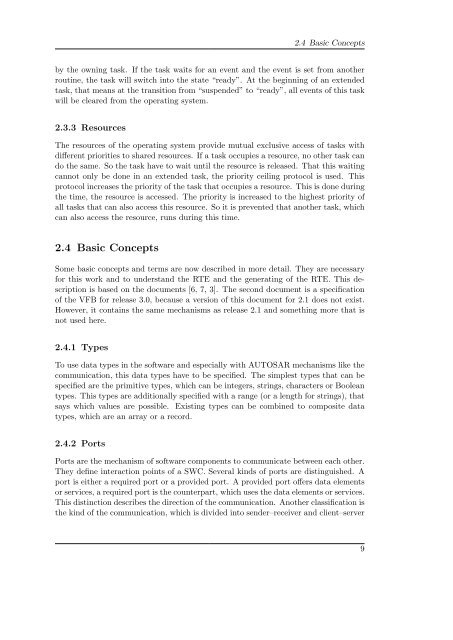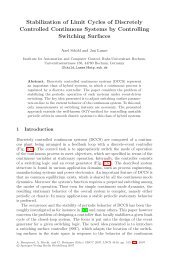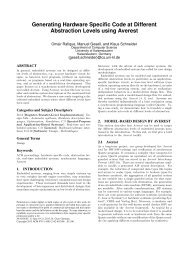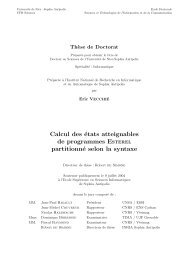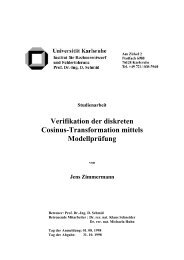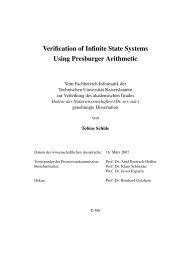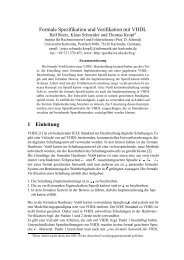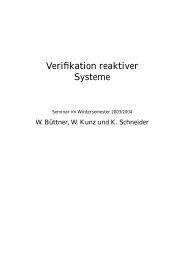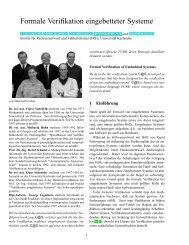Evaluation Environment for AUTOSAR-Autocode in Motor Control ...
Evaluation Environment for AUTOSAR-Autocode in Motor Control ...
Evaluation Environment for AUTOSAR-Autocode in Motor Control ...
You also want an ePaper? Increase the reach of your titles
YUMPU automatically turns print PDFs into web optimized ePapers that Google loves.
2.4 Basic Concepts<br />
by the own<strong>in</strong>g task. If the task waits <strong>for</strong> an event and the event is set from another<br />
rout<strong>in</strong>e, the task will switch <strong>in</strong>to the state “ready”. At the beg<strong>in</strong>n<strong>in</strong>g of an extended<br />
task, that means at the transition from “suspended” to “ready”, all events of this task<br />
will be cleared from the operat<strong>in</strong>g system.<br />
2.3.3 Resources<br />
The resources of the operat<strong>in</strong>g system provide mutual exclusive access of tasks with<br />
different priorities to shared resources. If a task occupies a resource, no other task can<br />
do the same. So the task have to wait until the resource is released. That this wait<strong>in</strong>g<br />
cannot only be done <strong>in</strong> an extended task, the priority ceil<strong>in</strong>g protocol is used. This<br />
protocol <strong>in</strong>creases the priority of the task that occupies a resource. This is done dur<strong>in</strong>g<br />
the time, the resource is accessed. The priority is <strong>in</strong>creased to the highest priority of<br />
all tasks that can also access this resource. So it is prevented that another task, which<br />
can also access the resource, runs dur<strong>in</strong>g this time.<br />
2.4 Basic Concepts<br />
Some basic concepts and terms are now described <strong>in</strong> more detail. They are necessary<br />
<strong>for</strong> this work and to understand the RTE and the generat<strong>in</strong>g of the RTE. This description<br />
is based on the documents [6, 7, 3]. The second document is a specification<br />
of the VFB <strong>for</strong> release 3.0, because a version of this document <strong>for</strong> 2.1 does not exist.<br />
However, it conta<strong>in</strong>s the same mechanisms as release 2.1 and someth<strong>in</strong>g more that is<br />
not used here.<br />
2.4.1 Types<br />
To use data types <strong>in</strong> the software and especially with <strong>AUTOSAR</strong> mechanisms like the<br />
communication, this data types have to be specified. The simplest types that can be<br />
specified are the primitive types, which can be <strong>in</strong>tegers, str<strong>in</strong>gs, characters or Boolean<br />
types. This types are additionally specified with a range (or a length <strong>for</strong> str<strong>in</strong>gs), that<br />
says which values are possible. Exist<strong>in</strong>g types can be comb<strong>in</strong>ed to composite data<br />
types, which are an array or a record.<br />
2.4.2 Ports<br />
Ports are the mechanism of software components to communicate between each other.<br />
They def<strong>in</strong>e <strong>in</strong>teraction po<strong>in</strong>ts of a SWC. Several k<strong>in</strong>ds of ports are dist<strong>in</strong>guished. A<br />
port is either a required port or a provided port. A provided port offers data elements<br />
or services, a required port is the counterpart, which uses the data elements or services.<br />
This dist<strong>in</strong>ction describes the direction of the communication. Another classification is<br />
the k<strong>in</strong>d of the communication, which is divided <strong>in</strong>to sender–receiver and client–server<br />
9


